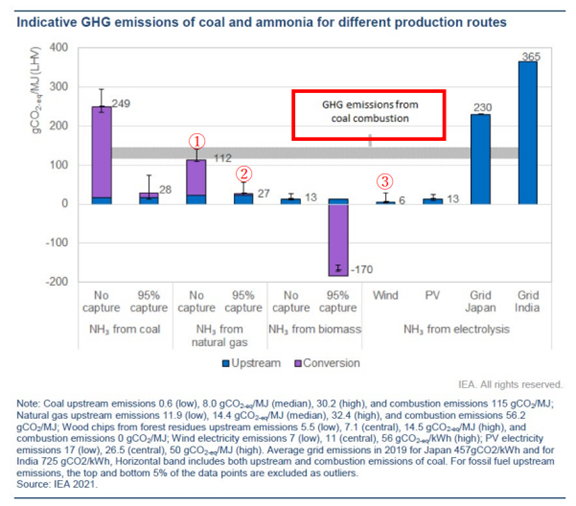
Home > FAQ 3


Could ammonia production processes lead an increase of CO2 emissions? (Isn’t the life cycle CO2 high?)
A. There are several methods to control the CO2 emissions during ammonia production, for instance, promoting the use of renewable energy sources such as wind/solar, incorporating CO2 capture and storage units (CCS), etc.


Details: Fuel ammonia can be produced from fossil fuels or renewable energy. In the case of ammonia production from fossil fuels, byproduct CO2 can be captured and stored (CCS) to fix CO2. Ammonia can be produced from renewable energy to reduce life cycle CO2 emissions.
For example, the report “The Role of Low-Carbon Fuels in the Clean Energy Transitions of the Power Sector”1) published by the International Energy Agency (IEA) in 2021 indicates the amount of greenhouse gases (GHG) emission from ammonia production by feedstock, i.e., coal, natural gas, biomass and water electrolysis.

- In the case of ammonia production from natural gas without CCS, GHG emissions are almost the same as when coal is burned as shown in the gray band in the Graph1. However, combining CCS can significantly reduce GHG emissions (Graph 2). CFAA’s internal studies have shown similar results.
- Efforts to reduce GHG emissions from natural gas production (”Upstream”)in Graph 2 are also underway. As a result, it is possible to reduce GHG emissions to the same level as synthesizing ammonia using renewable energy, i.e., Wind and PV. (Graph 3).
- It is also important to reduce GHG emissions from marine transporting of ammonia. While heavy oil is the most common carrier fuel, technological developments in ammonia-fueled marine engines are underway.
- Similarly, on the application side, demonstration tests of 20% ammonia co-firing with coal at the commercial coal-fired power plant are being prepared. Technology challenges to increase co-firing rates and dedicated firing is also undergoing.
- Significantly CO2 emissions reduction throughout the supply chain is expected by technological advances in the production, transportation, and application of ammonia as a fuel.
*1 International Energy Agency (IEA): An international organization that promotes global efforts to ensure energy security, economic growth, and environmental protection within the framework of the Organization for Economic Cooperation and Development (OECD). Participation is required of OECD member countries that meet the stockpiling standard (90 days of a country’s daily net oil imports in the previous year).
- Kobayashi, H. and Hayakawa, A., “Carbon-free Ammonia Combustion”, Journal of the Combustion Society of Japan, Vol.58, No.183 (2016) pp.41-48
- JERA Press Release, “JERA and IHI Move Up the Start of Large-Volume Co-firing of Fuel Ammonia in the Demonstration Project at Hekinan Thermal Power Station” (May 31, 2022)【Link】
- Murai, R., Nakatuka, N., Higashino, H., and Akamatsu, F., “Review of Fundamental Study on Ammonia Direct Combustion in Industrial Furnaces”, Journal of the Combustion Society of Japan, Vol. 61, No. 198 (2019), pp.320 -325
- Tomozawa, K. and Hattori, S., “Trends in the development of decarbonization technology in industrial furnaces”, Industrial heating, Vol. 59, No. 6 (2022) pp. 1-7. (in Japanese)
- IHI Press Release, ”CO₂-free power generation achieved with the world’s first gas turbine using 100% liquid ammonia –Reduction of over 99% greenhouse gases during combustion–2” (June 16, 2022)【Link】
- Shipping Zero Emission Project, ”Toward Achieving Net Zero GHG Emissions from International Shipping by 2050”(March 2022)【Link】

9F Takebashi Bldg., 2-1-8 Kandanishikicho, Chiyoda-ku, Tokyo 101-0054, Japan
EMAIL : office@greenammonia.org
